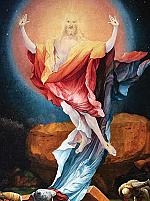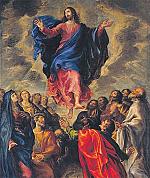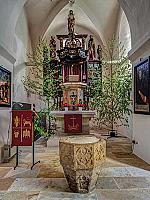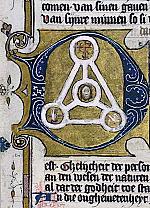The holiest week of the year
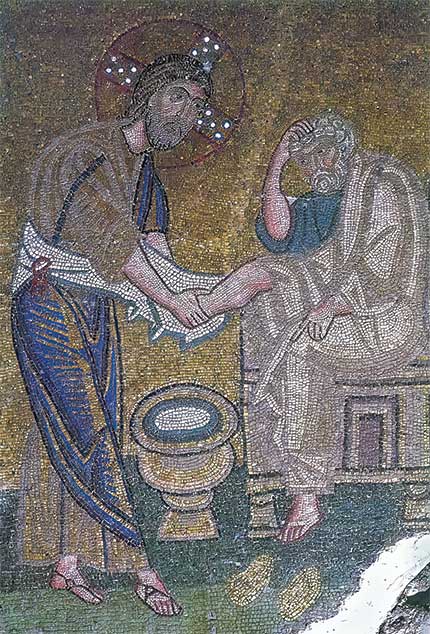
[ABOVE: Washing of the Apostles’ Feet, Detail of the inner narthex mosaic, Nea Moni, 11th Century. Chios, Greece—Nonimus / Public domain, Wikimedia]
The week between Palm Sunday and Easter has traditionally been considered the holiest week of the church year. This especially applies to the three days stretching from sundown on Maundy Thursday through sundown on Holy Saturday, called the Triduum; in our earliest evidence of Holy Week celebrations, these days were celebrated as one long worship service. In the West the normal term is Holy Week (sometimes Passion Week or Passiontide, although Passiontide can be a longer subsection of Lent). Orthodox Christians call it Great Week.
Where did it come from?
The development of Holy Week is intimately connected to the development of both Lent and Easter. Our earliest testimonies to the celebration of events connected with the Passion of Christ on certain corresponding days come from Jerusalem in the fourth century. These testimonies are very detailed because they come from the famous diary of Egeria, a woman probably from Spain who visited Jerusalem on pilgrimage, c. 381–384, and wrote down almost everything she saw and did for her “sisters” back home (most scholars think she was probably a nun). These Jerusalem observances eventually spread throughout the entire Roman Empire and remain influential on how liturgical churches currently observe Holy Week in both West and East.
How is the date determined?
Holy Week is always the week immediately preceding Easter Day. (For the different relationships between the 40 days of Lent and Holy Week in both Western and Eastern Christianity, see pages 23–25; for the computation of the date of Easter, see page 33.) In the West, Palm Sunday is considered the start of Holy Week, while in Eastern Christianity, Palm Sunday stands outside of both Great Lent and Great Week.
Theological themes
In the West
Palm Sunday is often now called, at least among liturgical Protestants, “Palm/Passion Sunday” to emphasize the connection of the triumphal entry into Jerusalem with the suffering Jesus will undergo during the week.
Monday and Tuesday in Holy Week are associated with traditional readings based on the actions that are believed to have occurred on these days in the Gospels. Wednesday in Holy Week, traditionally called Spy Wednesday, remembers Judas’s betrayal of Jesus.
Maundy Thursday remembers Jesus’s final time together with his disciples—the institution of the Lord’s Supper, the washing of the disciples’ feet, the prayer in the Garden of Gethsemane, and the betrayal and arrest of Jesus. In the synoptic Gospels (Matthew, Mark, and Luke), this meal with the disciples is said to occur on the same day as Passover; Jesus’s commands to the disciples about eating and drinking take place in the context of a Passover meal and resonate with Passover imagery. In John the meal takes place the day before Passover; other than Jesus washing the feet of the disciples, no particular customs are described. The word “maundy” comes from mandatum, the Latin word for “command,” as used by Jesus in John 13:34.
Good Friday commemorates the Crucifixion and its surrounding events. (“Good” refers to the day’s holiness and the good that it did us.) John aligns the Crucifixion with Passover lambs being slaughtered (John 19:14, 31–32).
Holy Saturday commemorates Jesus in the tomb. Traditionally the day also remembers the “Harrowing of Hell”—Jesus descending into hell to rescue those, from Adam and Eve on, who were held captive by sin and death.
At sundown on Holy Saturday, the Easter Vigil is celebrated as the first explosion of joy celebrating Christ’s Resurrection. Fully describing the Easter Vigil belongs to the next section, but the community of Maundy Thursday, the grief of Good Friday, and the quiet prayerful rest of Holy Saturday are all preparations for it.
In the East
Eastern Christians normally call all the days of Holy Week, or Great Week, “Great and Holy [day].”
On Monday, Tuesday, and Wednesday, as in the West, specific Gospels are read and themes emphasized according to the events that occurred on those days during the first Holy Week. In addition, Joseph son of Jacob is emphasized on Monday, the 10 virgins (Matthew 25:1–13) on Tuesday, and the woman who anointed Jesus, along with Judas’s betrayal, on Wednesday. Christ as the bridegroom of the church is emphasized on all three days.
Great and Holy Thursday focuses mainly on the institution of the Lord’s Supper and the command for footwashing. Great and Holy Friday honors the Crucifixion, and as in the West, Great and Holy Saturday remembers both Jesus’s repose in the tomb and his Harrowing of Hell. The Paschal Vigil, as it is usually termed in Orthodoxy, begins at 11:00 p.m. on Great and Holy Saturday.
Colors
In the West
Palm/Passion Sunday is red or sometimes purple. Maundy Thursday is always red. Because the altar is stripped in many Western churches on Maundy Thursday, color will be minimal on Good Friday and Holy Saturday, but if there is color, Good Friday is usually black, and Holy Saturday is black for any daytime service before sundown.
In the East
Green is used for Palm Sunday, red and black for Great and Holy Thursday, and black on Great and Holy Friday and Saturday.
Customs
Each day of Holy Week has developed separate customs, though all of them work to help believers experience the Passion’s events anew and prepare for the joy of Easter.
In the West
Palm/Passion Sunday begins with the blessing of palms, usually accompanied by the reading of a Gospel passage describing Jesus’s triumphal entry into Jerusalem and a procession around the church. In the latter part of the service, the entire account of the Passion from one of the synoptic Gospels is read (often by a group of readers who take the parts of different people in the narrative). Various contemplative services occur on Monday through Wednesday. A service of Tenebrae, meaning “darkness,” may occur on any of these days (it originally occurred during the Triduum, but in modern observance is scooted backward); it consists of the reading of psalms while candles are gradually extinguished, ending with a loud noise in complete darkness symbolizing Christ’s death on the cross.
Maundy or Holy Thursday is observed with a celebration of the Eucharist—even among churches that do not normally have a weekly Eucharist—and in many cases with footwashing. Sometimes the priest or pastor washes the feet of all who desire it; more frequently parishioners wash each other’s feet. At the end of the liturgy, the worship space is stripped of all decorations, and the service ends in silence and darkness. In denominations that keep the reserved sacrament (consecrated bread and wine left over from the Eucharist), even this is removed from the tabernacle (a small cabinet near the altar) and taken to some other part of the church, where parishioners often keep a prayer vigil during Thursday evening and Friday morning in memory of Jesus’s time in the Garden of Gethsemane.
Good Friday is a simple service with little music. The entire story of the Passion is read from the Gospel of John. Prayers are said for the whole church and the whole world, and a wooden cross is often brought into the sanctuary to be venerated. If people receive the Eucharist, they do so from the reserved sacrament. While the Stations of the Cross—a procession with prayer and readings through 14 representations of events of the Passion—may be done devotionally at any time of the year, a church service observing the stations often happens on Good Friday. If a service is held on Holy Saturday, it will be a simple one of Scripture and prayer.
In the East
Great Week in the East moves the Vespers (evening) liturgy, normally celebrated at sundown, earlier to enable increased attendance. Thus Great and Holy Monday begins with a Vespers service in the middle of the afternoon on Palm Sunday. Believers are encouraged to fast more strenuously during Holy Week than during the rest of Lent. Vespers services are celebrated on each day of Holy Week. On Wednesday evening, in addition to the Presanctified Liturgy that normally occurs every Wednesday of Lent, believers are anointed with oil in memory of Christ’s anointing and in preparation for the rest of the week.
Great and Holy Thursday services are held in the morning. Orthodox Christians are allowed to eat a cooked meal (without meat and dairy) during the day when the service is over. The Vespers of Great and Holy Friday is moved forward to Thursday evening and involves (as the Good Friday service often does in the West) the veneration of a large wooden cross. On Friday morning a service is observed that remembers Jesus being taken down from the cross and laid in the tomb. On Friday evening the Vespers of Holy Saturday is celebrated, which involves prayer and lamentation over Jesus’s tomb. Finally, on Holy Saturday, a liturgy focused on the Harrowing of Hell will be celebrated, and during this service the liturgical colors will be changed from Lenten to Easter ones, a foretaste of the joy to come. CH
Some things you can do in church
• The best way to experience Holy Week is in church. Commit to attending as many services as you can. Raise joyous shouts, face your own culpability in Christ’s death, pledge yourself to him again in the Eucharist, sorrow with the disciples, feel the tragedy, kneel at the foot of the cross, sit in darkness, and stand on the very edge of the Easter Vigil to peer from the darkness of sin and death into the light of the coming glorious morning.
By Jennifer Woodruff Tait
[Christian History originally published this article in Christian History Issue #156+ in 2025]
Jennifer Woodruff Tait is Senior Editor of CH magazineNext articles
Celebrating the risen Savior
Jesus’s Resurrection is the event on which everything else about the Christian faith depends.
Jennifer Woodruff TaitAscension
He ascended into heaven and is seated at the right hand of God the Father Almighty.
Jennifer Woodruff TaitTrinity, All Saints, Christ the King
Special prayers and offices devoted to the doctrine of the Trinity date back as far as the fourth-century Arian controversy
Jennifer Woodruff TaitSupport us
Christian History Institute (CHI) is a non-profit Pennsylvania corporation founded in 1982. Your donations support the continuation of this ministry
Donate



